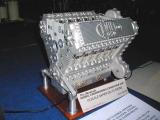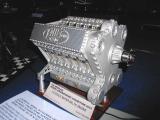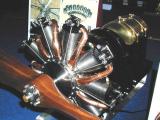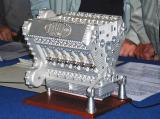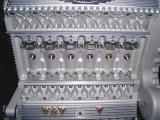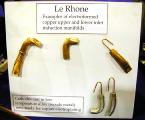Click on a photo to view it full sized.
In Ken's own words:
I just spent a day at the Midlands exhibition, stocking up with metals, and seeking bargains.
There were two exhibits of note, each for different reasons. There was a part built Deltic engine, the work was so crisp and so complex only photos of a very large file size could do it justice, but you will have to make do with sensible sized ones. It was absolutely stunning. As we say in Yorksire " I were gobsmacked!".
The other pictures have a different interest. The LeRhone engine in the picture had superb copper pipework, and the other picture shows how it was done. The builder made undersize patterns from woods metal [you know, the pipe bending stuff that melts in boiling water] then copper plated the patterns. He then simply melted-out the woods metal and was left with superb copper work. Brilliant.
The Deltic requires new adjectives that I currently lack. Ken believes there is a lot of CNC work in it, but that in no way detracts from the achievement (the learning curve for CNC is steep!) Some background on the Deltic was provided by David Owen:
The Deltic was made in several capacities, with outputs ranging to about
4500bhp.
It was a high-revving engine, running around 3000rpm and despite its
complexity, had a reliable reputation.
I think it came out in the late 40s, was used in fast patrol boats by US
and British, was used in Australian minesweepers and a great number were
used in the Deltic diesel-electric locomotives which remained in service
into the 70s.
Each loco had two Deltics. I have heard them running at high power and
they are most impressive. Remember we have 72 pistons here! I also saw a
Deltic in London (Victoria Station?) and experienced deltic haze, which
was a phenomenon peculiar to these locos. After idling for some time,
the lower cylinders oil up and exhaust tremedous amount of oil smoke
when the train moves off.
I have also seen Deltic engines in the flesh. A local scrapper had a
yard full of them, as well as a fair number of Hall Scott V12 Invaders,
which were petrol engines. All these came from the Australian Navy. I
bought several pieces of Deltic parts fixtures and am still using odd
bits.
The Deltics I saw were very big engines from minesweepers and would have
been 6 feet long and about 5 feet across, from memory. They also had
none of the lettering detail, as on the engine you saw Ken. I think your
engine must have been a latterday version, possibly built by someone
other than Napiers.
Napier built some incredible (incredibly complex!) engines and they have
always fascinated me, from the classic Lion to the mind-blowing Sabre.
I wonder when someone will tackle a Napier Nomad?
If you'd like to know more about the Deltic, have a look at the PTF site. Note that the engine is as described by David: 36 pistons in 18 cylinders, while the 1/8 scale model proclaims itself to be 18 pistons (in 18 visible cylinders). Either there was another Deltic of this configuration, or the model had to make some accomodations to scale.
This page designed to look best when using anything but IE!
Please submit all questions and comments to
[email protected]
Thats it
EMB
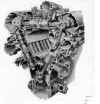 The Deltic is one of the most complex engines made, but in many ways
typical of Napier products. It has three sets of six cylinders forming a
triangle, the crankshafts being in the apex. Each cylinder is double
ended, with opposing pistons, 36 in all.
It is similar to the Jumo diesels, being a 2-stroke uniflow type. One
piston uncovers a swirl transfer belt, the opposing piston the exhaust.
Scavenging and charging air is pumped from a centrifugal blower (s) into
a manifold centred on each bank.
The Deltic is one of the most complex engines made, but in many ways
typical of Napier products. It has three sets of six cylinders forming a
triangle, the crankshafts being in the apex. Each cylinder is double
ended, with opposing pistons, 36 in all.
It is similar to the Jumo diesels, being a 2-stroke uniflow type. One
piston uncovers a swirl transfer belt, the opposing piston the exhaust.
Scavenging and charging air is pumped from a centrifugal blower (s) into
a manifold centred on each bank.
ozmb
![]()
